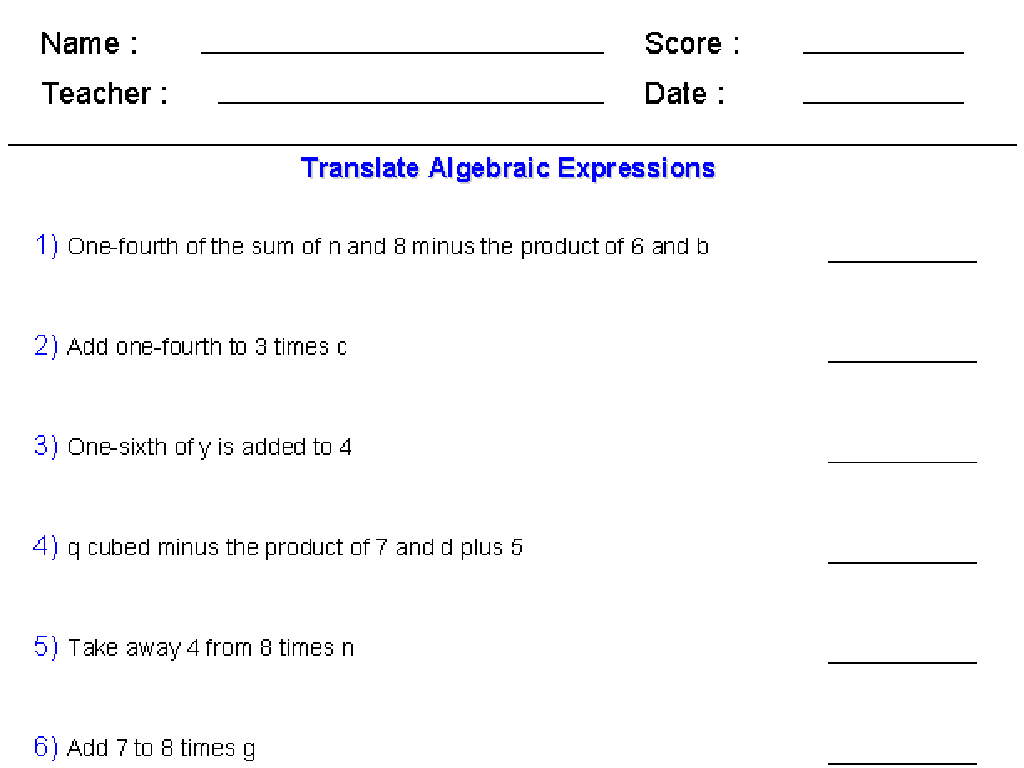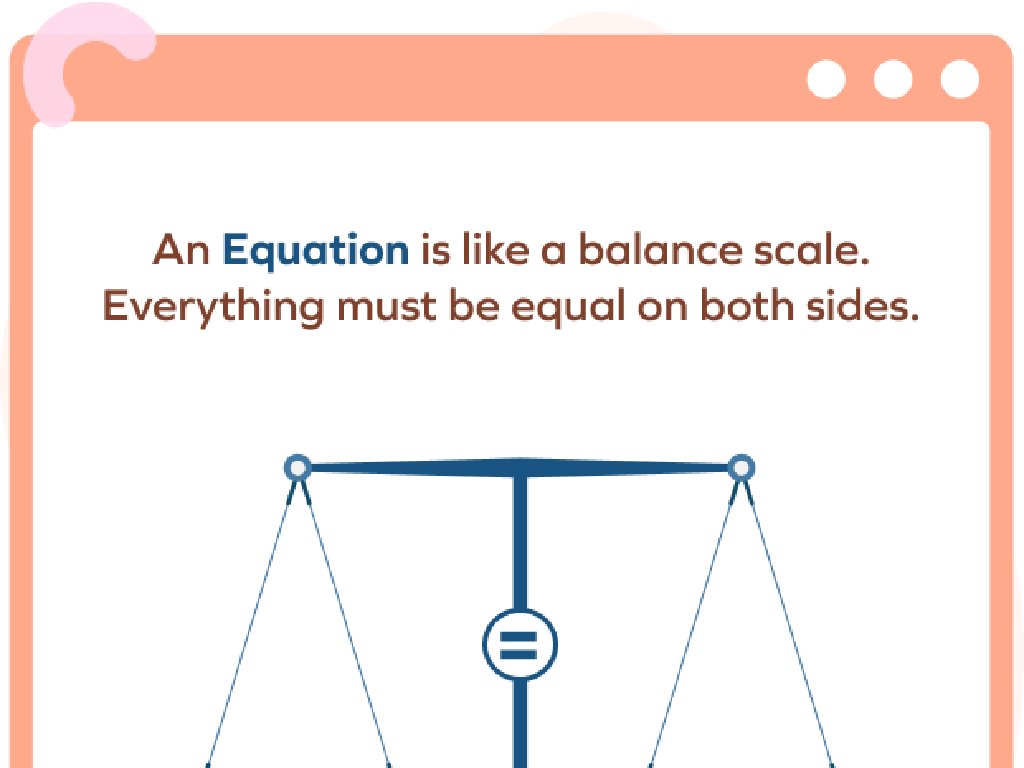Multiply Two Fractions
Subject: Math
Grade: Fifth grade
Topic: Multiply Fractions
Please LOG IN to download the presentation. Access is available to registered users only.
View More Content
Introduction to Multiplying Fractions
– Understanding fractions basics
– Fractions represent parts of a whole, like 1/2 a pizza
– Multiplication as repeated addition
– Multiplying is like adding something over and over
– Importance of multiplying fractions
– Used in cooking, science, and budgeting
– Visualizing fraction multiplication
– Draw pictures to see how parts combine when multiplied
|
Begin the lesson by reviewing the concept of fractions, emphasizing that they represent parts of a whole. Explain multiplication as the process of adding a number to itself a certain number of times, and then relate this to fractions. Discuss real-world applications of multiplying fractions, such as in recipes or dividing resources, to show its relevance. Introduce visual aids, like fraction circles or bars, to help students grasp how fractions can be multiplied and combined to form new fractions. This foundational understanding will set the stage for practical exercises in the following lessons.
Visualizing Fraction Multiplication
– Use pie charts for fractions
– Pie charts show fractions as parts of a whole
– Combining pieces by multiplying
– Each piece of one pie is multiplied by pieces of another
– Example: Multiply 1/2 by 1/3
– 1/2 pie multiplied by 1/3 gives 1/6 of the whole pie
|
This slide aims to help students visualize the concept of multiplying fractions using pie charts. By representing fractions as parts of a pie, students can see how these parts combine to form a new fraction. For example, if we take half of a pie and then take a third of that half, we are left with one-sixth of the original pie. This visual representation reinforces the concept that multiplying fractions is essentially finding a part of a part. Encourage students to draw their own pie charts for different fraction multiplications to solidify their understanding.
Multiplying Fractions: The Rules
– Multiply the top numbers
– If we have 1/2 and 3/4, we multiply 1 and 3
– Multiply the bottom numbers
– For 1/2 and 3/4, we multiply 2 and 4
– Simplify the fraction
– If we get 3/8, it’s already simple, but 2/4 becomes 1/2
|
When teaching multiplication of fractions, start by explaining that the numerators (top numbers) are multiplied together and the denominators (bottom numbers) are also multiplied together. Use visual aids or fraction tiles if possible to show this process. After the multiplication, the fraction should be simplified to its lowest terms, which may involve finding the greatest common divisor. Provide several examples with different levels of complexity, and encourage students to practice with fractions that both do and do not require simplification. This will help them understand the concept more deeply and prepare them for more complex problems.
Multiplying Fractions: Step-by-Step Example
– Multiply the numerators: 2 x 3
– Numerators are the top numbers of the fractions
– Multiply the denominators: 3 x 4
– Denominators are the bottom numbers of the fractions
– Simplify the result: 6/12
– Use division to find the simplest form
– Final answer: 1/2
– Reducing 6/12 gives us the simplest form, 1/2
|
This slide provides a clear example of how to multiply two fractions using the numbers 2/3 and 3/4. Start by multiplying the numerators (top numbers) to get the new numerator. Then, multiply the denominators (bottom numbers) to get the new denominator. Next, simplify the fraction by finding the greatest common divisor and dividing both the numerator and denominator by it. In this case, 6/12 simplifies to 1/2. Make sure to explain each step thoroughly and encourage students to practice with additional examples. Discuss the importance of simplifying fractions to their simplest form.
Multiplying Fractions: Practice Time
– Let’s multiply 1/4 by 2/5 together
– Multiply the numerators, then the denominators: (1*2)/(4*5)
– Try 3/8 by 1/2 on your own
– Follow the same steps: (3*1)/(8*2)
– Share your answers with the class
– Discuss the methods used
|
This slide is designed to engage students in practicing the multiplication of fractions. Start by solving the first problem as a class, demonstrating the process of multiplying the numerators to get the new numerator and the denominators to get the new denominator. Then, encourage students to attempt the second problem independently to reinforce their understanding. Afterward, create a collaborative environment where students can share their answers and explain the methods they used. This will help them learn from each other and clarify any misunderstandings. Provide guidance and correct misconceptions as needed. The goal is to build confidence and ensure that students are comfortable with the process of multiplying fractions.
Common Mistakes in Multiplying Fractions
– Avoid adding numerators or denominators
– Always simplify your answer
– Reduce fractions to their simplest form
– Check your work with a classmate
– Discuss and verify each other’s solutions
– Practice makes perfect
|
When teaching students to multiply fractions, it’s crucial to highlight common errors to avoid. Emphasize that unlike addition, when multiplying fractions, we multiply the numerators together and the denominators together, without adding them. After finding the product, students should simplify the fraction to its lowest terms, which may require finding the greatest common divisor. Encourage students to work in pairs to check each other’s work, fostering collaboration and reinforcing the concept. Lastly, remind them that mastering fraction multiplication comes with practice, and provide ample opportunities for them to do so.
Class Activity: Fraction Multiplication Game
– Team up with a classmate
– Roll dice to form fractions
– Each number rolled represents a numerator or denominator
– Multiply your fractions together
– Use multiplication rules for fractions
– First to 5 correct wins the game
– Keep score, verify answers with teacher
|
This interactive game is designed to help students practice multiplying fractions in a fun and engaging way. Students will pair up and use dice to generate numerators and denominators for their fractions. They will then multiply these fractions together, applying the rules they’ve learned for fraction multiplication. The first pair to correctly multiply and simplify 5 sets of fractions wins the game. As a teacher, circulate the room to assist and verify the accuracy of the students’ work. Possible variations of the activity could include using different-sided dice for more variety, incorporating mixed numbers, or challenging students to create the largest or smallest product possible.
Conclusion: Mastering Fraction Multiplication
– Recap key multiplication steps
– Multiply numerators, then denominators. Simplify if needed.
– Understand the skill’s importance
– Useful for real-life problems like cooking or dividing things equally.
– Homework: Practice worksheet
– Keep practicing for mastery
– Consistent practice helps solidify understanding.
|
As we wrap up today’s lesson on multiplying two fractions, it’s important to review the steps we’ve learned: multiply the numerators to get the new numerator, and multiply the denominators for the new denominator. Emphasize the importance of this skill in everyday life, such as cooking or dividing items into smaller parts. Assign the provided worksheet for homework to give students the opportunity to apply what they’ve learned. Encourage them to practice regularly, as repetition will help them become more comfortable and proficient with multiplying fractions.





